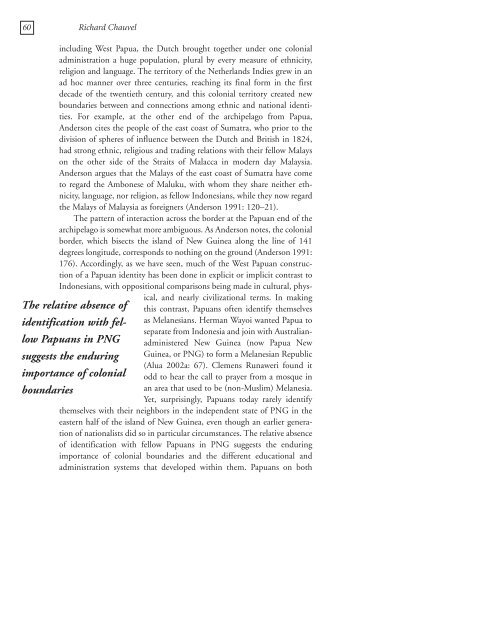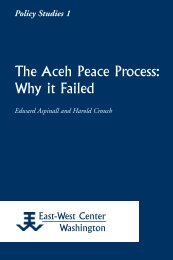Constructing Papuan Nationalism: History, Ethnicity ... - ScholarSpace
Constructing Papuan Nationalism: History, Ethnicity ... - ScholarSpace
Constructing Papuan Nationalism: History, Ethnicity ... - ScholarSpace
- No tags were found...
You also want an ePaper? Increase the reach of your titles
YUMPU automatically turns print PDFs into web optimized ePapers that Google loves.
60 Richard Chauvelincluding West Papua, the Dutch brought together under one colonialadministration a huge population, plural by every measure of ethnicity,religion and language. The territory of the Netherlands Indies grew in anad hoc manner over three centuries, reaching its final form in the firstdecade of the twentieth century, and this colonial territory created newboundaries between and connections among ethnic and national identities.For example, at the other end of the archipelago from Papua,Anderson cites the people of the east coast of Sumatra, who prior to thedivision of spheres of influence between the Dutch and British in 1824,had strong ethnic, religious and trading relations with their fellow Malayson the other side of the Straits of Malacca in modern day Malaysia.Anderson argues that the Malays of the east coast of Sumatra have cometo regard the Ambonese of Maluku, with whom they share neither ethnicity,language, nor religion, as fellow Indonesians, while they now regardthe Malays of Malaysia as foreigners (Anderson 1991: 120–21).The pattern of interaction across the border at the <strong>Papuan</strong> end of thearchipelago is somewhat more ambiguous. As Anderson notes, the colonialborder, which bisects the island of New Guinea along the line of 141degrees longitude, corresponds to nothing on the ground (Anderson 1991:176). Accordingly, as we have seen, much of the West <strong>Papuan</strong> constructionof a <strong>Papuan</strong> identity has been done in explicit or implicit contrast toIndonesians, with oppositional comparisons being made in cultural, physical,and nearly civilizational terms. In makingthis contrast, <strong>Papuan</strong>s often identify themselvesas Melanesians. Herman Wayoi wanted Papua toseparate from Indonesia and join with AustralianadministeredNew Guinea (now Papua NewGuinea, or PNG) to form a Melanesian Republic(Alua 2002a: 67). Clemens Runaweri found itodd to hear the call to prayer from a mosque inan area that used to be (non-Muslim) Melanesia.Yet, surprisingly, <strong>Papuan</strong>s today rarely identifythemselves with their neighbors in the independent state of PNG in theeastern half of the island of New Guinea, even though an earlier generationof nationalists did so in particular circumstances. The relative absenceof identification with fellow <strong>Papuan</strong>s in PNG suggests the enduringimportance of colonial boundaries and the different educational andadministration systems that developed within them. <strong>Papuan</strong>s on bothThe relative absence ofidentification with fellow<strong>Papuan</strong>s in PNGsuggests the enduringimportance of colonialboundaries
















